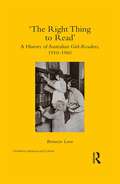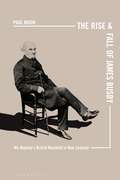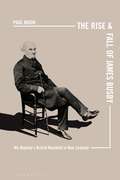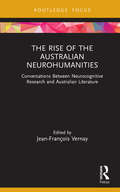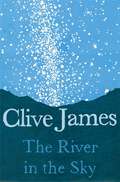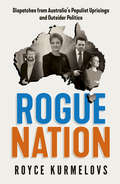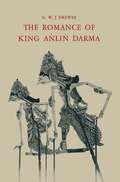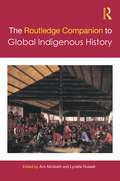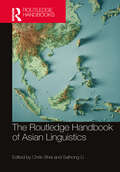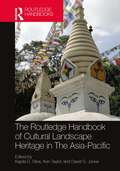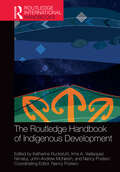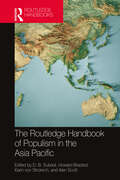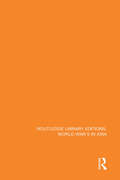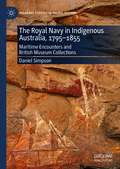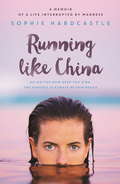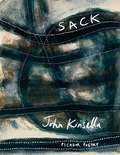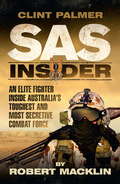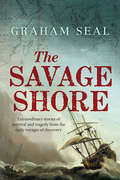- Table View
- List View
‘The Right Thing to Read’: A History of Australian Girl-Readers, 1910-1960
by Bronwyn Lowe‘The Right Thing to Read’: A History of Australian Girl-Readers, 1910-1960 explores the reading habits, identity, and construction of femininity of Australian girls aged between ten and fourteen from 1910 to 1960. It investigates changing notions of Australian girlhood across the period, and explores the ways that parents, teachers, educators, journalists and politicians attempted to mitigate concerns about girls’ development through the promotion of ‘healthy’ literature. The book also addresses the influence of British publishers to Australian girl-readers and the growing importance of Australian publishers throughout the period. It considers the rise of Australian literary nationalism in the global context, and the increasing prominence of Australian literature in the period after the Second World War. It also shows how access to reading material improved for girls over the first half of the last century.
‘The Right Thing to Read’: A History of Australian Girl-Readers, 1910-1960
by Bronwyn Lowe‘The Right Thing to Read’: A History of Australian Girl-Readers, 1910-1960 explores the reading habits, identity, and construction of femininity of Australian girls aged between ten and fourteen from 1910 to 1960. It investigates changing notions of Australian girlhood across the period, and explores the ways that parents, teachers, educators, journalists and politicians attempted to mitigate concerns about girls’ development through the promotion of ‘healthy’ literature. The book also addresses the influence of British publishers to Australian girl-readers and the growing importance of Australian publishers throughout the period. It considers the rise of Australian literary nationalism in the global context, and the increasing prominence of Australian literature in the period after the Second World War. It also shows how access to reading material improved for girls over the first half of the last century.
The Rise and Fall of James Busby: His Majesty’s British Resident in New Zealand
by Paul MoonOne of the British Empire's most troubling colonial exports in the 19th-century, James Busby is known as the father of the Australian wine industry, the author of New Zealand's Declaration of Independence and a central figure in the early history of independent New Zealand as its British Resident from 1833 to 1840.Officially the man on the ground for the British government in the volatile society of New Zealand in the 1830s, Busby endeavoured to create his own parliament and act independently of his superiors in London. This put him on a collision course with the British Government, and ultimately destroyed his career. With a reputation as an inept, conceited and increasingly embittered person, this caricature of Busby's character has slipped into the historical bloodstream where it remains to the present day. This book draws on an extensive range of previously-unused archival records to reconstruct Busby's life in much more intimate form, and exposes the back-room plotting that ultimately destroyed his plans for New Zealand. It will alter the way that Britain's colonisation of New Zealand is understood, and will leave readers with an appreciation of how individuals, more than policies, shaped the Empire and its rule.
The Rise and Fall of James Busby: His Majesty’s British Resident in New Zealand
by Paul MoonOne of the British Empire's most troubling colonial exports in the 19th-century, James Busby is known as the father of the Australian wine industry, the author of New Zealand's Declaration of Independence and a central figure in the early history of independent New Zealand as its British Resident from 1833 to 1840.Officially the man on the ground for the British government in the volatile society of New Zealand in the 1830s, Busby endeavoured to create his own parliament and act independently of his superiors in London. This put him on a collision course with the British Government, and ultimately destroyed his career. With a reputation as an inept, conceited and increasingly embittered person, this caricature of Busby's character has slipped into the historical bloodstream where it remains to the present day. This book draws on an extensive range of previously-unused archival records to reconstruct Busby's life in much more intimate form, and exposes the back-room plotting that ultimately destroyed his plans for New Zealand. It will alter the way that Britain's colonisation of New Zealand is understood, and will leave readers with an appreciation of how individuals, more than policies, shaped the Empire and its rule.
The Rise of the Australian Neurohumanities: Conversations Between Neurocognitive Research and Australian Literature (Routledge Focus on Literature)
by Jean-François VernayThis exciting one-of-a-kind volume brings together new contributions by geographically diverse authors who range from early career researchers to well-established scholars in the field. It unprecedentedly showcases a wide variety of the latest research at the intersection of Australian literary studies and cognitive literary studies in a single volume. It takes Australian fiction on the leading edge by paving the way for a new direction in Australian literary criticism.
The Rise of the Australian Neurohumanities: Conversations Between Neurocognitive Research and Australian Literature (Routledge Focus on Literature)
by Jean-François VernayThis exciting one-of-a-kind volume brings together new contributions by geographically diverse authors who range from early career researchers to well-established scholars in the field. It unprecedentedly showcases a wide variety of the latest research at the intersection of Australian literary studies and cognitive literary studies in a single volume. It takes Australian fiction on the leading edge by paving the way for a new direction in Australian literary criticism.
The River in the Sky: A Poem
by Clive James'One of the most important and influential writers of our time' Sunday TimesClive James has been close to death for several years, and he has written about the experience in a series of deeply moving poems. In Sentenced to Life, he was clear-sighted as he faced the end, honest about his regrets. In Injury Time, he wrote about living well in the time remaining, focusing our attention on the joys of family and art, and celebrating the immediate beauty of the world.At the opening of The River in the Sky, a book-length poem, we find James in ill health but high spirits. Although his body traps him in his Cambridge house, his mind is free to roam. The River in the Sky takes us on a grand tour of ‘the fragile treasures of his life’. Animated by powerful recollections, James presents a flowing stream of vivid images. He moves from emotionally resonant personal moments, such as listening to jazz records with his future wife, to unforgettable encounters with all kinds of culture: Beethoven’s Ninth Symphony sits alongside ‘YouTube’s vast cosmopolis’. As ever with James, he shares his passions with enormous generosity, making brilliant and original connections, and fearlessly tackling the biggest questions: the meaning of life and how to live it. In the end, what emerges from this autobiographical epic is a soaring work of exceptional depth and overwhelming feeling, a new marvel for the modern age.
Rogue Nation: Fascinating, relevant, compelling – the one book about Australian politics you must read
by Royce KurmelovsReporting from the backrooms and corridors of Parliament House in Canberra to the streets of post-industrial Burnie in Tasmania, the struggling rural communities of Gippsland and the Queensland heartland, Royce Kurmelovs captures with perceptive, real-time analysis the rise of Australian populism.The people and places he profiles tell the story of those independent political figures who have tried to take power from the outside and those who feel abandoned by both the left and right of politics. Overshadowing it all is the controversial figure of Pauline Hanson, a woman who came back from oblivion to become a powerbroker just as the country breathlessly watched the election of Donald Trump and wondered whether the same could happen here. ROGUE NATION is essential reading for anyone who wants to know what is happening to politics in this country, and what the future might hold.
The Routledge Companion to Global Indigenous History (Routledge Companions)
by Ann McGrath Lynette RussellThe Routledge Companion to Global Indigenous History presents exciting new innovations in the dynamic field of Indigenous global history while also outlining ethical, political, and practical research. Indigenous histories are not merely concerned with the past but have resonances for the politics of the present and future, ranging across vast geographical distances and deep time periods. The volume starts with an introduction that explores definitions of Indigenous peoples, followed by six thematic sections which each have a global spread: European uses of history and the positioning of Indigenous people as history’s outsiders; their migrations and mobilities; colonial encounters; removals and diasporas; memory, identities, and narratives; deep histories and pathways towards future Indigenous histories that challenge the nature of the history discipline itself. This book illustrates the important role of Indigenous history and Indigenous knowledges for contemporary concerns, including climate change, spirituality and religious movements, gender negotiations, modernity and mobility, and the meaning of ‘nation’ and the ‘global’. Reflecting the state of the art in Indigenous global history, the contributors suggest exciting new directions in the field, examine its many research challenges and show its resonances for a global politics of the present and future. This book is invaluable reading for students in both undergraduate and postgraduate Indigenous history courses.
The Routledge Companion to Global Indigenous History (Routledge Companions)
by Ann McGrath Lynette RussellThe Routledge Companion to Global Indigenous History presents exciting new innovations in the dynamic field of Indigenous global history while also outlining ethical, political, and practical research. Indigenous histories are not merely concerned with the past but have resonances for the politics of the present and future, ranging across vast geographical distances and deep time periods. The volume starts with an introduction that explores definitions of Indigenous peoples, followed by six thematic sections which each have a global spread: European uses of history and the positioning of Indigenous people as history’s outsiders; their migrations and mobilities; colonial encounters; removals and diasporas; memory, identities, and narratives; deep histories and pathways towards future Indigenous histories that challenge the nature of the history discipline itself. This book illustrates the important role of Indigenous history and Indigenous knowledges for contemporary concerns, including climate change, spirituality and religious movements, gender negotiations, modernity and mobility, and the meaning of ‘nation’ and the ‘global’. Reflecting the state of the art in Indigenous global history, the contributors suggest exciting new directions in the field, examine its many research challenges and show its resonances for a global politics of the present and future. This book is invaluable reading for students in both undergraduate and postgraduate Indigenous history courses.
The Routledge Handbook of Asian Linguistics
by Chris Shei Saihong LiThe Routledge Handbook of Asian Linguistics provides a comprehensive overview of the ways in which Asian languages should be conceptualized as a whole, the distinct characteristics of each language group, and the relationships and results of interactions between the languages and language families in Asia. Asia is the largest and the most populous continent on Earth, and the site of many of the first civilizations. This Handbook aims to provide a systematic overview of Asian languages in both theoretical and functional perspectives, optimally combining the two in intercultural settings. In other words, the text will provide a reference for researchers of individual Asian languages or language groups against the background of the entire range of Asian languages. Not only does the Handbook act as a reference to a particular language, it also connects each language to other Asian languages in the perspective of the entire Asian continent. Cultural roles and communicative functions of language are also emphasized as an important domain where the various Asian languages interact and shape each other. With extensive coverage of both theoretical and applied linguistic topics, The Routledge Handbook of Asian Linguistics is an indispensable resource for students and researchers working in this area.
The Routledge Handbook of Asian Linguistics
by Chris Shei Saihong LiThe Routledge Handbook of Asian Linguistics provides a comprehensive overview of the ways in which Asian languages should be conceptualized as a whole, the distinct characteristics of each language group, and the relationships and results of interactions between the languages and language families in Asia. Asia is the largest and the most populous continent on Earth, and the site of many of the first civilizations. This Handbook aims to provide a systematic overview of Asian languages in both theoretical and functional perspectives, optimally combining the two in intercultural settings. In other words, the text will provide a reference for researchers of individual Asian languages or language groups against the background of the entire range of Asian languages. Not only does the Handbook act as a reference to a particular language, it also connects each language to other Asian languages in the perspective of the entire Asian continent. Cultural roles and communicative functions of language are also emphasized as an important domain where the various Asian languages interact and shape each other. With extensive coverage of both theoretical and applied linguistic topics, The Routledge Handbook of Asian Linguistics is an indispensable resource for students and researchers working in this area.
The Routledge Handbook of Cultural Landscape Heritage in The Asia-Pacific (Routledge Handbooks on Museums, Galleries and Heritage)
by Kapila D. Silva Ken Taylor David S. JonesThe Routledge Handbook of Cultural Landscape Heritage in the Asia-Pacific revisits the use, growth, and potential of the cultural landscape methodology in the conservation and management of culture-nature heritage in the Asia-Pacific region. Taking both a retrospective and prospective view of the management of cultural heritage in the region, this volume argues that the plurality and complexity of heritage in the region cannot be comprehensively understood and effectively managed without a broader conceptual framework like the cultural landscape approach. The book also demonstrates that such an approach facilitates the development of a flexible strategy for heritage conservation. Acknowledging the effects of rapid socio-economic development, globalization, and climate change, contributors examine the pressure these issues place on the sustenance of cultural heritage. Including chapters from more than 20 countries across the Asia-Pacific region, the volume reviews the effectiveness of theoretical and practical potentials afforded by the cultural landscape approach and examines how they have been utilized in the Asia-Pacific context for the last three decades. The Routledge Handbook of Cultural Landscape Heritage in the Asia-Pacific provides a comprehensive analysis of the processes of cultural landscape heritage conservation and management. As a result, it will be of interest to academics, students, and professionals who are based in the fields of cultural heritage management, architecture, urban planning, landscape architecture, and landscape management.
The Routledge Handbook of Cultural Landscape Heritage in The Asia-Pacific (Routledge Handbooks on Museums, Galleries and Heritage)
by Ken Taylor David S. Jones Kapila D. SilvaThe Routledge Handbook of Cultural Landscape Heritage in the Asia-Pacific revisits the use, growth, and potential of the cultural landscape methodology in the conservation and management of culture-nature heritage in the Asia-Pacific region. Taking both a retrospective and prospective view of the management of cultural heritage in the region, this volume argues that the plurality and complexity of heritage in the region cannot be comprehensively understood and effectively managed without a broader conceptual framework like the cultural landscape approach. The book also demonstrates that such an approach facilitates the development of a flexible strategy for heritage conservation. Acknowledging the effects of rapid socio-economic development, globalization, and climate change, contributors examine the pressure these issues place on the sustenance of cultural heritage. Including chapters from more than 20 countries across the Asia-Pacific region, the volume reviews the effectiveness of theoretical and practical potentials afforded by the cultural landscape approach and examines how they have been utilized in the Asia-Pacific context for the last three decades. The Routledge Handbook of Cultural Landscape Heritage in the Asia-Pacific provides a comprehensive analysis of the processes of cultural landscape heritage conservation and management. As a result, it will be of interest to academics, students, and professionals who are based in the fields of cultural heritage management, architecture, urban planning, landscape architecture, and landscape management.
The Routledge Handbook of Indigenous Development (Routledge International Handbooks)
by Katharina Ruckstuhl Irma A. Velásquez Nimatuj John-Andrew McNeish Nancy PosteroThis Handbook inverts the lens on development, asking what Indigenous communities across the globe hope and build for themselves. In contrast to earlier writing on development, this volume focuses on Indigenous peoples as inspiring theorists and potent political actors who resist the ongoing destruction of their livelihoods. To foster their own visions of development, they look from the present back to Indigenous pasts and forward to Indigenous futures. Key questions: How do Indigenous theories of justice, sovereignty, and relations between humans and non-humans inform their understandings of development? How have Indigenous people used Rights of Nature, legal pluralism, and global governance systems to push for their visions? How do Indigenous relations with the Earth inform their struggles against natural resource extraction? How have native peoples negotiated the dangers and benefits of capitalism to foster their own life projects? How do Indigenous peoples in diaspora and in cities around the world contribute to Indigenous futures? How can Indigenous intellectuals, artists, and scientists control their intellectual property and knowledge systems and bring into being meaningful collective life projects? The book is intended for Indigenous and non-Indigenous activists, communities, scholars, and students. It provides a guide to current thinking across the disciplines that converge in the study of development, including geography, anthropology, environmental studies, development studies, political science, and Indigenous studies.
The Routledge Handbook of Indigenous Development (Routledge International Handbooks)
by Katharina Ruckstuhl Irma A. Velásquez Nimatuj John-Andrew McNeish Nancy PosteroThis Handbook inverts the lens on development, asking what Indigenous communities across the globe hope and build for themselves. In contrast to earlier writing on development, this volume focuses on Indigenous peoples as inspiring theorists and potent political actors who resist the ongoing destruction of their livelihoods. To foster their own visions of development, they look from the present back to Indigenous pasts and forward to Indigenous futures. Key questions: How do Indigenous theories of justice, sovereignty, and relations between humans and non-humans inform their understandings of development? How have Indigenous people used Rights of Nature, legal pluralism, and global governance systems to push for their visions? How do Indigenous relations with the Earth inform their struggles against natural resource extraction? How have native peoples negotiated the dangers and benefits of capitalism to foster their own life projects? How do Indigenous peoples in diaspora and in cities around the world contribute to Indigenous futures? How can Indigenous intellectuals, artists, and scientists control their intellectual property and knowledge systems and bring into being meaningful collective life projects? The book is intended for Indigenous and non-Indigenous activists, communities, scholars, and students. It provides a guide to current thinking across the disciplines that converge in the study of development, including geography, anthropology, environmental studies, development studies, political science, and Indigenous studies.
The Routledge Handbook of Populism in the Asia Pacific (Indo-Pacific in Context)
by D. B. Subedi Howard Brasted Karin Von Strokirch Alan ScottThis handbook brings national and thematic case studies together to examine a variety of populist politics from local and comparative perspectives in the Asia Pacific. The chapters consider key and cross cutting themes such as populism and nationalism, religion, ethnicity and gender, as well as authoritarianism. They show how populist politics alters the way governments mediate state-society relations. The essays in this volume consider: • diverse approaches in populist politics, for example, post-colonial, strategic vs ideational, growth and redistribution, leadership styles, and in what ways they are similar to, or different from, populist discourses in Europe and the United States; • under what social, political, economic and structural conditions populist politics has emerged in the Asia-Pacific region; • national case studies drawn from South, East and Southeast Asia as well as the Pacific analyzing themes such as media, religion, gender, medical populism, corruption and cronyism, and inclusive vs exclusive forms of populist politics; • modes and techniques of social and political mobilization that populist politicians employ to influence people and their impact on the way democracy is conceived and practiced in the Asia Pacific. As a systematic account of populist ideologies, strategies, leaders and trends in the Asia Pacific, this handbook is essential reading for scholars of area studies, especially in the Asia Pacific, politics and international relations, and political and social theory.
The Routledge Handbook of Populism in the Asia Pacific (Indo-Pacific in Context)
This handbook brings national and thematic case studies together to examine a variety of populist politics from local and comparative perspectives in the Asia Pacific. The chapters consider key and cross cutting themes such as populism and nationalism, religion, ethnicity and gender, as well as authoritarianism. They show how populist politics alters the way governments mediate state-society relations. The essays in this volume consider: • diverse approaches in populist politics, for example, post-colonial, strategic vs ideational, growth and redistribution, leadership styles, and in what ways they are similar to, or different from, populist discourses in Europe and the United States; • under what social, political, economic and structural conditions populist politics has emerged in the Asia-Pacific region; • national case studies drawn from South, East and Southeast Asia as well as the Pacific analyzing themes such as media, religion, gender, medical populism, corruption and cronyism, and inclusive vs exclusive forms of populist politics; • modes and techniques of social and political mobilization that populist politicians employ to influence people and their impact on the way democracy is conceived and practiced in the Asia Pacific. As a systematic account of populist ideologies, strategies, leaders and trends in the Asia Pacific, this handbook is essential reading for scholars of area studies, especially in the Asia Pacific, politics and international relations, and political and social theory.
Routledge Library Editions: World War II in Asia (Routledge Library Editions: World War II in Asia)
by Timothy Hall John J. SbregaThe 4 volumes in this set, originally published between 1980 and 1983, bring to light and focus on the conflict between Japan and Australia and Japan and the USA. Timothy Hall’s volumes, richly illustrated with black & white photographs, used highly contentious documents as their sources and give fascinating insights into a period of Australian history which is sometimes less than gloious. John J. Sbrega’s tour de force is not only one of the most extensive annotated bibliographies on the USA and Japan in World War 2 ever published, but it also provides invaluable information on lesser known but no less important aspects of the conflict.
The Royal Navy in Indigenous Australia, 1795–1855: Maritime Encounters and British Museum Collections (Palgrave Studies in Pacific History)
by Daniel SimpsonThis book offers the first in-depth enquiry into the origins of 135 Indigenous Australian objects acquired by the Royal Navy between 1795 and 1855 and held now by the British Museum. In response to increasing calls for the ‘decolonisation’ of museums and the restitution of ethnographic collections, the book seeks to return knowledge of the moments, methods, and motivations whereby Indigenous Australian objects were first collected and sent to Britain. By structuring its discussion in terms of three key ‘stages’ of a typical naval voyage to Australia—departure from British shores, arrival on the continent’s coasts, and eventual return to port—the book offers a nuanced and multifaceted understanding of the pathways followed by these 135 objects into the British Museum. The book offers important new understandings of Indigenous Australian peoples’ reactions to naval visitors, and contains a wealth of original research on the provenance and meaning of some of the world’s oldest extant Indigenous Australian object collections.
Running Like China: A memoir of a life interrupted by madness
by Sophie HardcastleFrom a talented emerging Australian writer, a brave, honest, unforgettable memoir about mental illness that breaks the silence and shatters the taboos to give hope to all those struggling to find their way through.'When I was eleven years old Mum told me, "One crowded hour of glorious life is worth an age without a name." Even before I heard these words I was always a child who crammed intense joy into tiny pockets of time.'One day Sophie Hardcastle realised the joy she'd always known had disappeared. She was constantly tired, with no energy, no motivation and no sense of enjoyment for surfing, friends, conversations, movies, parties, family - for anything. Her hours became empty. And then, the month before she turned seventeen, that emptiness filled with an intense, unbearable sadness that made her scream and tear at her skin. Misdiagnosed with chronic fatigue, then major depression, then temporal lobe epilepsy, she was finally told - three years, two suicide attempts and five hospital admissions later - that she had Bipolar 1 Disorder.In this honest and beautifully told memoir, Sophie lays bare her story of mental illness - of a teenage girl using drugs, alcohol and sex in an attempt to fix herself; of her family's anguish and her loss of self. It is a brave and hopeful story of adaptation, learning to accept and of ultimately realising that no matter how deep you have sunk, the surface is always within reach. Running Like China shatters the silence and smashes the taboos around mental illness. It is an unforgettable story.
Sack
by John KinsellaIn John Kinsella's new collection, 'Sack' not only refers not only to the shocking title poem, where a tied, writhing sack is seen flung from a car into gully - but also to the sacking and exploitation of the landscape and those who labour on it. Kinsella draws vividly on 'childhood memories' - but reveals them for the hard truths they are, by subtracting the cushioning effects of nostalgia. Kinsella shows how childhood prefigures our adult experience, and how its residues (here, those also take the literal form of asbestos and radiation) influence and shape our futures. Elsewhere, Kinsella resurrects an old form to do new work: the 'penillion' is an old Welsh stanza whose concision and insistent musicality provide the ideal means to encapsulate and concentrate Kinsella's vision of the land, animal life, and our sometimes fraught relationship with both. These short poems reveal astonishing and unsuspected correlations between music and form, place and language - and will come as a delightful surprise to those who know Kinsella primarily as a freewheeling long-form poet. But throughout Sack, the articulate urgency of Kinsella's lyric builds to nothing so much as a call to action, and underlines John Kinsella's reputation as one of the greatest Australian poets of the last fifty years.
SAS Insider: An elite SAS fighter on life in Australia's toughest and most secretive combat unit (Hachette Military Collection #3)
by Clint Palmer Robert MacklinThe true story of Australia's SAS and the soldier who was there from the start.Clint Palmer has spent much of his adult life in the SAS and has fought in this elite military unit as it developed from its fledgling beginnings into the highly trained, specialised fighting force it is today. He is an insider with the long view and this is his unique story of life in the SAS.As a bush kid in the Northern Territory of Australia, growing up in a one dog mining town, Palmer's best friends were mostly Aboriginal kids, and the outside world barely existed. But he always had one driving ambition - the army. Enduring the toughest of tough training, Palmer soon demonstrated his fighting capabilities and became part of the Australian SAS. So began almost thirty years of service.We go with him to Iraq and Afghanistan, where he is at the heart of some of the worst fighting in Operation Anaconda in the Shahi-Kot Valley in 2002. He lets us in on what it's like to have made well over a thousand parachute jumps, many of them in terrible conditions and into treacherous terrain which may have ended not just his career but his life. And he shares with us how this adrenalin fuelled world has become a lifelong commitment.Palmer is the man who knows the Regiment almost better than anyone, so SAS Insider really is the inside story of the SAS - and a gripping account of one Australian soldier's life at the sharp end.Robert Macklin is a well-known Australian biographer and historian with more than twenty books to his credit. His most recent books include One False Move, Dark Paradise and the bestselling SAS Sniper which he co-wrote with Rob Maylor.
The Savage Shore: Extraordinary Stories of Survival and Tragedy from the Early Voyages of Discovery
by Graham SealFor centuries before the arrival in Australia of Captain Cook and the so-called First Fleet in 1788, intrepid seafaring explorers had been searching, with varied results, for the fabled “Great Southland.” In this enthralling history of early discovery, Graham Seal offers breathtaking tales of shipwrecks, perilous landings, and Aboriginal encounters with the more than three hundred Europeans who washed up on these distant shores long before the land was claimed by Cook for England. The author relates dramatic, previously untold legends of survival gleaned from the centuries of Dutch, Spanish, Portuguese, French, and Indonesian voyages to Australia, and debunks commonly held misconceptions about the earliest European settlements: ships of the Dutch East Indies Company were already active in the region by the early seventeenth century, and the Dutch, rather than the English, were probably the first European settlers on the continent.
